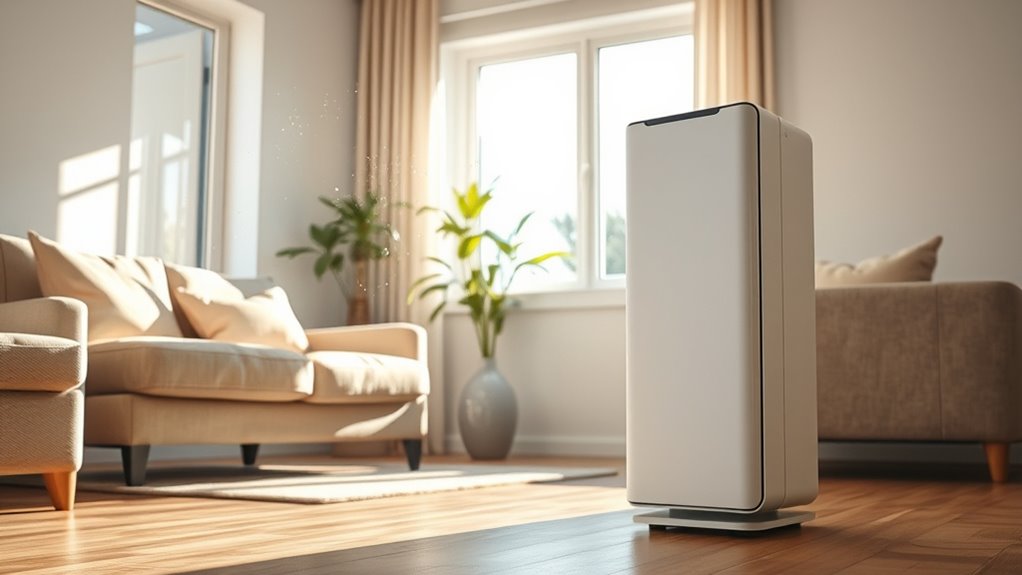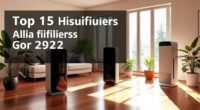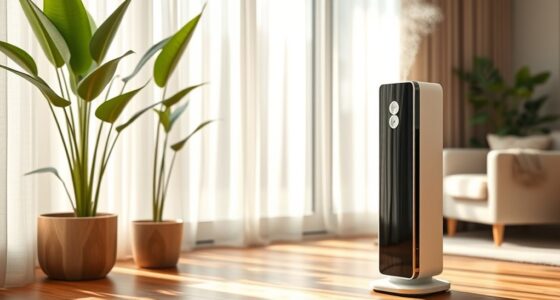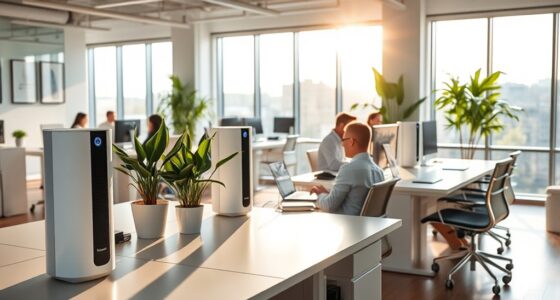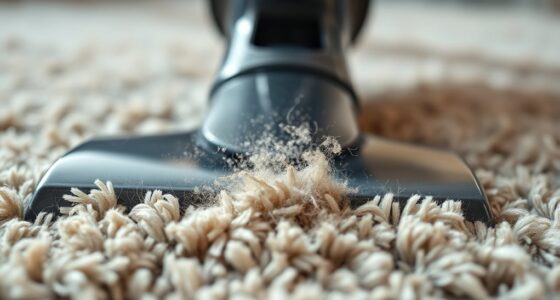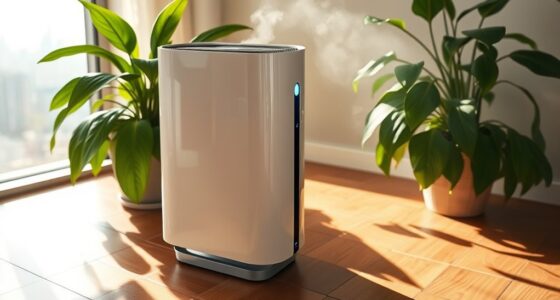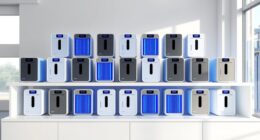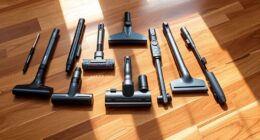Air purifiers considerably reduce household dust, improving your indoor air quality. They use HEPA filters that capture up to 99.97% of particles, including dust, allergens, and microplastics. By regularly running an air purifier, you can lower dust concentrations, leading to a healthier environment. It is crucial to maintain your purifier by replacing filters as needed and placing it in high-traffic areas for maximum effectiveness. Discover more tips on optimizing air purifiers and enhancing your home’s air quality.
Key Takeaways
- Air purifiers equipped with HEPA filters can capture up to 99.97% of airborne dust and allergens, significantly improving indoor air quality.
- Regular use of air purifiers can reduce household dust concentration by 12% to 52%, helping alleviate respiratory issues.
- Proper placement of air purifiers in high-traffic areas enhances airflow and maximizes dust filtration effectiveness.
- Maintaining indoor humidity below 60% complements air purifiers, further reducing dust accumulation and improving air quality.
- Routine maintenance, including timely filter replacements, ensures air purifiers operate efficiently, capturing maximum dust and allergens.
Understanding Household Dust and Its Impact on Air Quality
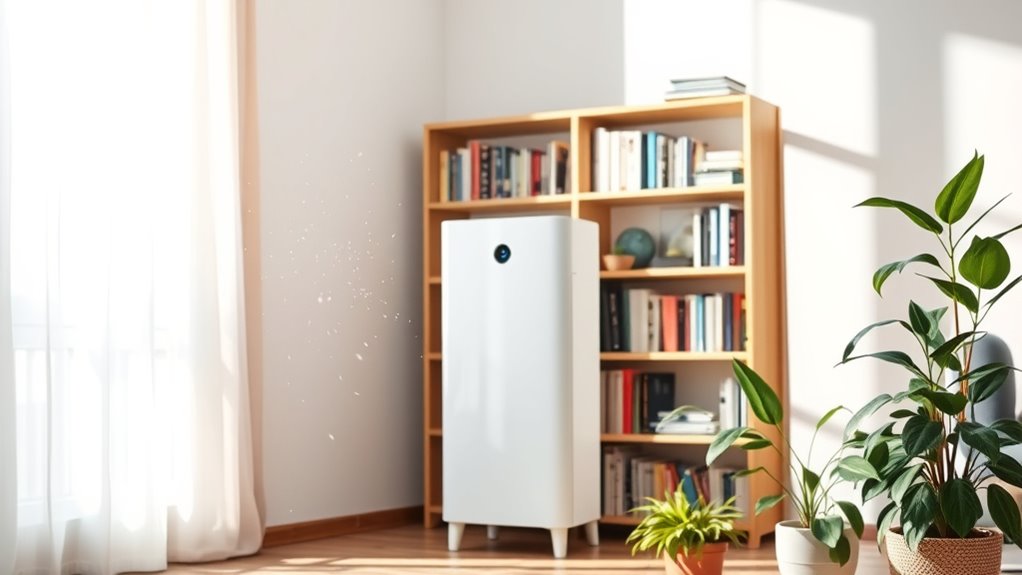
Household dust, often overlooked, plays a notable role in indoor air quality. It’s primarily made up of human debris like dead skin cells, hair, and fibers, contributing to poor indoor air. Dust accumulation can introduce common indoor pollutants such as pet dander, mold spores, and microplastics, which can trigger allergens and worsen respiratory health. When indoor air is 2 to 5 times more polluted than outdoor air, the effects can lead to asthma symptoms, eye irritation, and coughing. Additionally, using air purifiers with HEPA filtration can significantly capture these small particles, enhancing the air quality in your home. Clean Air Delivery Rates (CADR) of air purifiers are essential for assessing their effectiveness in reducing dust and allergens. Regular cleaning and maintenance of air purifiers can further enhance performance, ensuring they effectively reduce dust in your living space. Air purifiers with smart features can provide real-time air quality monitoring, allowing you to adjust settings for optimal dust reduction.
To combat this, maintaining indoor humidity levels below 60% is essential. Utilizing air purifiers equipped with HEPA filters can notably reduce dust and improve your overall air quality, helping you breathe easier and live healthier. Regular use of air purifiers can also lead to improved respiratory health, further enhancing your living environment.
How Air Purifiers Function to Reduce Dust
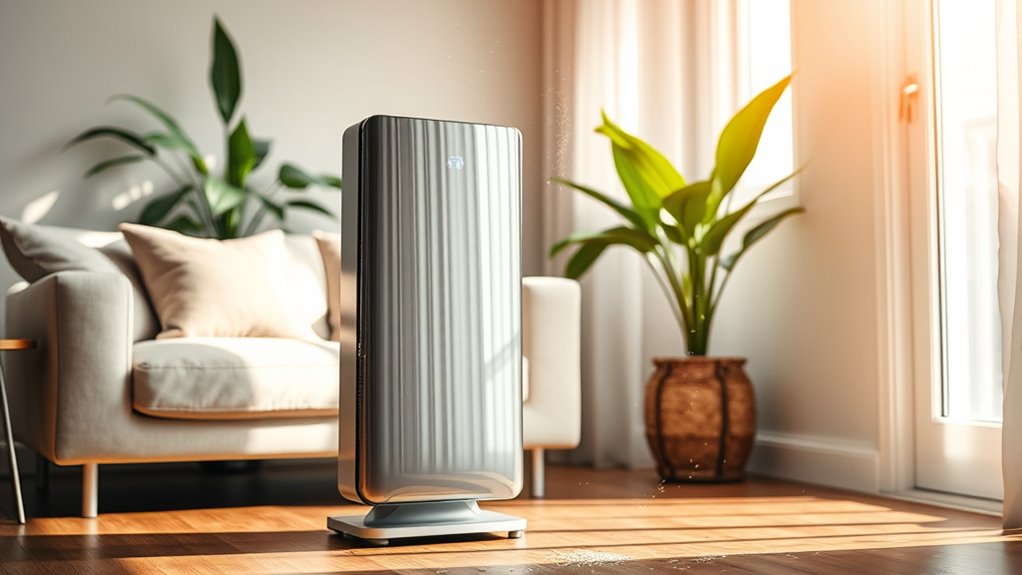
Air purifiers reduce dust by drawing in air and filtering it through specialized systems. With HEPA filters capturing tiny particles and pre-filters handling larger debris, these devices work efficiently to improve your indoor air quality. Additionally, many air purifiers come equipped with smart features that allow users to monitor air quality and adjust settings for optimal performance. Regular maintenance of these devices can ensure they remain effective in reducing energy consumption and improving overall air quality. Regular filter cleaning is essential to maintain their dust-fighting capabilities. Placing your air purifier strategically and keeping it running continuously can further enhance its dust-fighting capabilities. Some models offer real-time monitoring that provides users with instant feedback on air quality levels. Properly maintaining your air purifier will also help in maximizing its filter efficiency over time.
Airflow and Filtration Process
While you mightn’t notice it, indoor air can be filled with dust and allergens that affect your health and comfort.
Air purifiers help combat this issue through a smart airflow and filtration process. Here’s how they work:
- They draw in indoor air and pass it through pre-filters, capturing larger particles like hair and lint.
- Next, the air goes through HEPA filters, trapping up to 99.97% of dust particles as small as 0.3 microns. This filtration process is crucial for maintaining a healthy environment, as emotional and psychological growth can be affected by air quality. Additionally, maintaining color accuracy in your viewing environment can further enhance the overall ambiance of your home. Moreover, regular maintenance of air purifiers can significantly improve indoor air quality, ensuring that the system operates effectively over time. Routine cleaning of your furniture can also help minimize the dust that accumulates in your living space.
- Continuous circulation improves the effectiveness of reducing dust, as air purifiers consistently filter the air. Additionally, a clean indoor environment can enhance cultural engagement and overall well-being, similar to the vibrant activities found in urban areas like Harrisburg.
HEPA Filter Efficiency
Indoor environments often harbor a range of allergens and fine dust particles that can impact your well-being. HEPA filters in air purifiers capture up to 99.97% of airborne dust, including dust mites and pollen. This high dust removal efficiency greatly reduces dust concentration by 12% to 52% when used regularly. Additionally, the power of imagination can inspire you to maintain a cleaner living space, enhancing your commitment to a healthier home environment. Many air purifiers, such as the Winix 5500-2, utilize advanced technologies to further improve air quality. Regular socialization with pets can contribute to a healthier home environment, as it encourages a cleaner and more organized living space. Not only do these air purifiers improve indoor air quality, but they also enhance your respiratory health by eliminating various allergens. Furthermore, maintaining clean air is vital for skin health, as pollutants can negatively affect your complexion. Additionally, maintaining clean air can support gut microbiota health, which is essential for overall well-being.
To maximize their effectiveness, keep your air purifiers running continuously in high-traffic areas, allowing them to cycle and clean the air efficiently.
Strategic Placement Importance
To effectively reduce dust in your home, strategically placing air purifiers is essential. Proper placement enhances dust removal efficiency by ensuring unobstructed airflow.
Here are some tips for ideal placement:
- Position air purifiers in high-traffic areas where dust accumulates quickly.
- Keep them away from walls and obstructions to maximize airflow.
- Place units near sources of dust, like pet areas or windows, to capture airborne particles before they settle.
Additionally, consider the Clean Air Delivery Rate (CADR) when selecting a model. A higher CADR means better performance for your room size, leading to ideal dust reduction. Furthermore, utilizing energy-efficient technology in your air purification system can enhance overall air quality while reducing energy costs.
The Importance of HEPA Filters in Air Purifiers

When it comes to improving your home’s air quality, HEPA filters play an essential role in air purifiers.
These High-Efficiency Particulate Air filters capture up to 99.97% of particles as small as 0.3 microns, making them highly effective against dust and allergens.
If you have pets, you’ll appreciate how HEPA filters trap pet dander and hair, common contributors to household dust. This greatly enhances your indoor air quality and helps alleviate allergy symptoms.
However, to maintain their effectiveness, regular maintenance is vital, including timely filter replacements.
Not all air purifiers are equal, so choose models specifically labeled with true HEPA filters for the best dust and allergen removal capabilities.
Your health and comfort depend on it!
Benefits of Using Air Purifiers for Dust Management
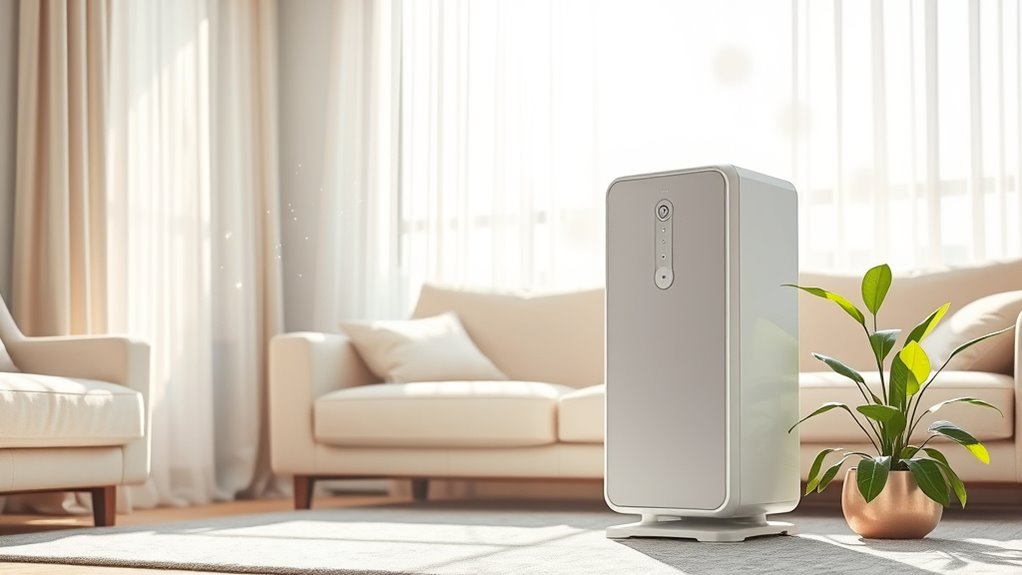
Using air purifiers can greatly enhance your home’s air quality by effectively filtering out dust particles.
With HEPA filters capturing nearly all dust, you’ll notice a cleaner environment and fewer allergy symptoms.
Regularly running your purifier guarantees that you maintain a dust-free space, leading to a healthier living area.
Effective Dust Filtration
Air purifiers equipped with HEPA filters offer a powerful solution for managing household dust, as they can capture up to 99.97% of airborne particles as small as 0.3 microns.
By regularly using air purifiers, you can markedly reduce dust levels in your home, improving indoor air quality.
Here are some key benefits of effective dust filtration:
- Notable Reduction: Expect airborne dust concentrations to drop by 12% to 52%.
- Efficient Performance: Choose purifiers with a high Clean Air Delivery Rate (CADR) for better dust removal.
- Optimal Usage: Guarantee continuous operation and proper placement in high-traffic areas for maximum effectiveness.
With these strategies, you’ll enjoy a cleaner, healthier living space free from airborne allergens.
Improved Indoor Air Quality
Improved indoor air quality becomes a reality with the right air purifier in your home, as it effectively filters out dust and allergens.
Air purifiers equipped with HEPA filters capture up to 99.97% of airborne dust particles, dramatically reducing dust concentrations by 12% to 52%. This reduction alleviates allergy symptoms and respiratory issues, creating a healthier living space for you and your family.
With consistently improved air quality, you may notice better sleep and enhanced cognitive function.
Additionally, air purifiers help minimize dust accumulation, protecting your furniture and electronics from damage.
Strategies for Maintaining Air Purifiers for Optimal Performance
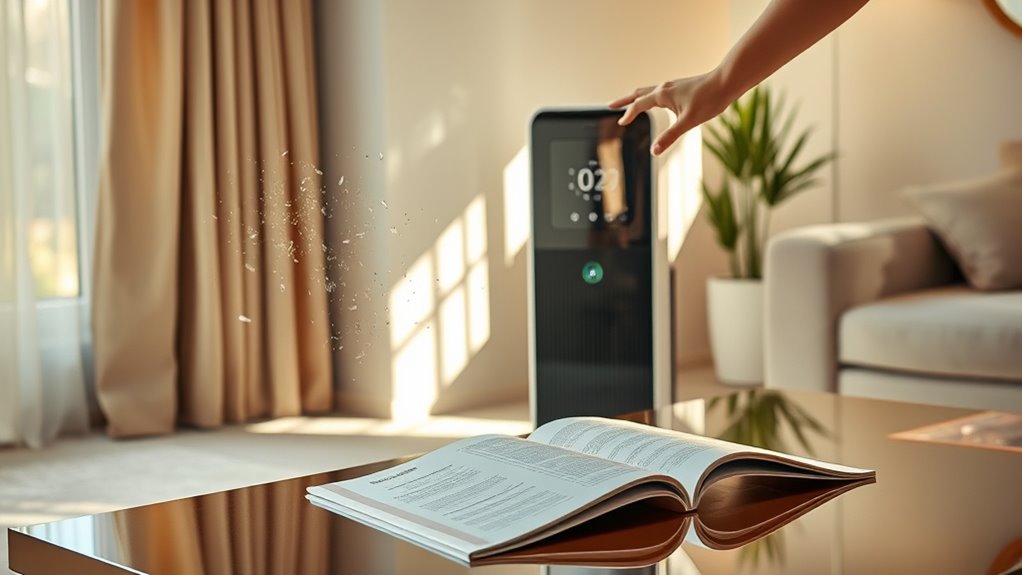
To guarantee your air purifier operates at its best, regular maintenance is essential. Here are some strategies to keep your device running efficiently:
- Regularly replace or clean filters according to the manufacturer’s guidelines to maintain peak air quality and performance.
- Monitor air quality indicators on the purifier to know when maintenance is needed, ensuring effective dust removal.
- Position the air purifier in high-traffic areas and away from obstructions to enhance airflow and maximize dust removal capabilities.
Additionally, don’t forget to clean the exterior frequently to prevent dust buildup.
You can also use a vacuum with a HEPA filter around the unit, which helps maintain efficiency by keeping the surrounding area free from excess dust.
Additional Cleaning Practices to Complement Air Purifiers
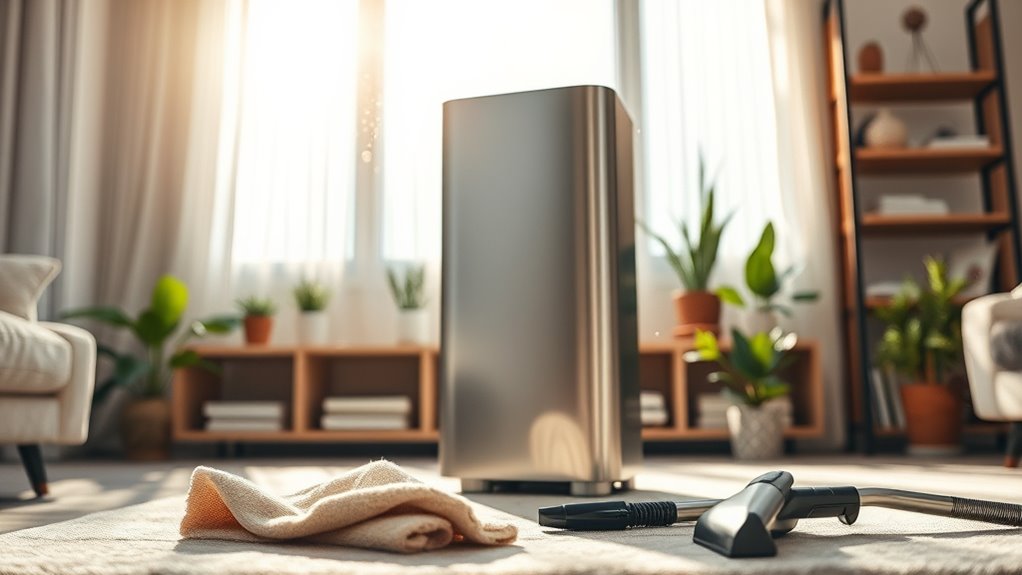
While air purifiers play an essential role in reducing dust and improving indoor air quality, incorporating additional cleaning practices can greatly enhance their effectiveness.
Regular vacuuming with a HEPA-filtered vacuum captures dust particles that may settle on surfaces, complementing the action of your air purifiers.
Regularly using a HEPA-filtered vacuum effectively captures dust, enhancing the performance of your air purifiers.
Dusting with microfiber cloths traps dust effectively, preventing it from becoming airborne.
Wash bedding, pet beds, and curtains in hot water frequently to eliminate dust mites and their waste, which air purifiers might miss.
Maintaining indoor humidity levels between 30-50% helps reduce dust mite populations and mold growth.
Finally, decluttering your living spaces minimizes surfaces for dust to accumulate, allowing air purifiers to maintain cleaner air more efficiently.
Air Purifiers and Allergies: A Connection
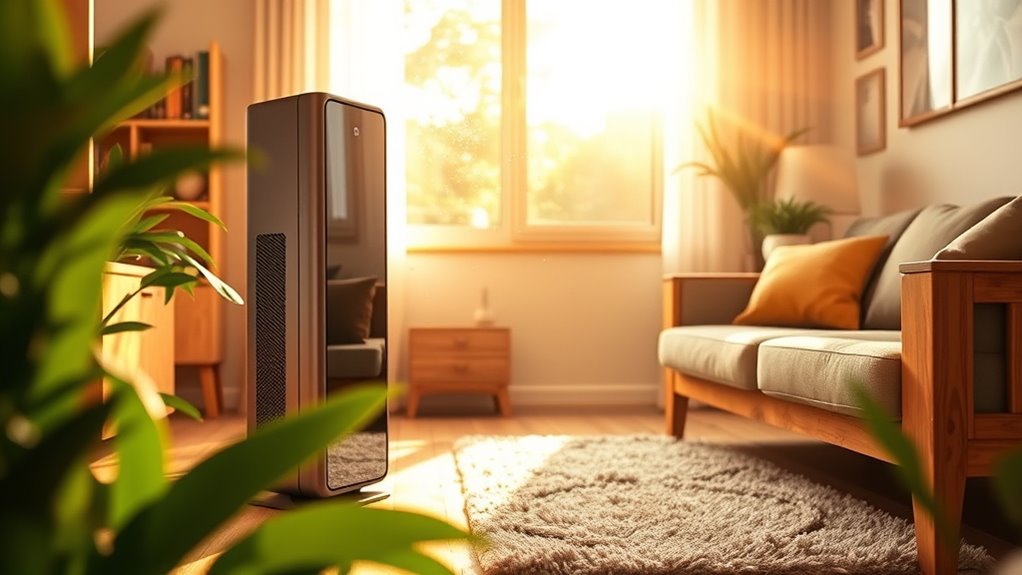
Air purifiers can greatly alleviate allergy symptoms by removing airborne allergens from your home. When equipped with HEPA filters, they can capture up to 99.97% of irritants like dust mites and pollen, markedly improving your air quality.
Regular use can help you:
- Reduce dust concentration by 12% to 52%
- Minimize allergy triggers and flare-ups, such as sneezing and itching
- Enhance your overall respiratory health
Incorporating air purifiers into your daily routine not only combats indoor dust but also works best as part of a thorough dust management strategy.
Pairing them with regular cleaning and vacuuming guarantees you maintain a healthier indoor environment, making it easier to breathe freely and enjoy your space without the nagging discomfort of allergies.
Choosing the Right Air Purifier for Your Home
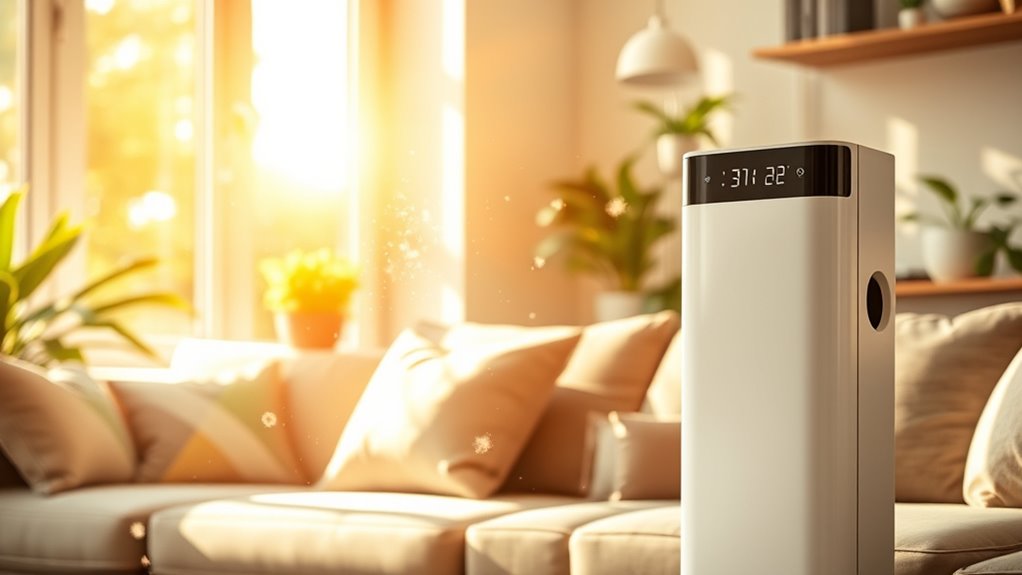
How do you choose the right air purifier for your home? Start by looking for models with HEPA filters, as they capture 99.97% of particles, including dust and allergens.
Next, check the Clean Air Delivery Rate (CADR); a higher CADR means more effective dust reduction, especially in larger spaces.
A higher Clean Air Delivery Rate (CADR) ensures more effective dust reduction, particularly in larger rooms.
Make certain the air purifier fits your room size—undersized units won’t filter air efficiently.
Consider noise levels too; if you plan to use it in bedrooms, opt for models that operate quietly while maintaining performance.
Finally, remember regular maintenance is key. Follow the manufacturer’s guidelines for checking and replacing effective filters to guarantee peak air quality and continued dust reduction in your home.
Frequently Asked Questions
Do Air Purifiers Remove Dust From a House?
Yes, air purifiers do remove dust from your house. They use specialized filters, like HEPA filters, that capture tiny dust particles, improving your indoor air quality considerably.
To get the best results, make sure you place the purifier in high-traffic areas and keep it running continuously.
Regularly clean and replace the filters to maintain efficiency. With proper care, you’ll notice a marked reduction in dust levels throughout your home.
What Is the Best Dust Control for a House?
The best dust control for your house involves a combination of strategies.
Regularly vacuum with a HEPA-filtered vacuum to capture dust and prevent it from becoming airborne again.
Keep humidity levels between 30-50% to deter dust mites, and wash bedding and curtains frequently in hot water.
Implement a cleaning routine that includes dusting with microfiber cloths to trap dust effectively.
These steps will help you maintain a cleaner, healthier indoor environment.
Where Should I Put My Air Purifier for Dust?
You should place your air purifier in high-traffic areas, like your living room or bedroom, where dust tends to accumulate.
Make sure it’s at least 2-4 feet away from walls or furniture for ideal airflow.
Keep doors and windows closed while it’s running to prevent outside dust from coming back in.
If you have a larger home, consider using multiple purifiers to cover each room effectively.
Regularly move it around to target different dust hotspots.
How Long Does It Take for an Air Purifier to Remove Dust?
When you use an air purifier, you’ll notice that it can start reducing dust within minutes.
However, for you to see significant improvements in air quality, it usually takes several hours of continuous operation.
Depending on the model and room size, expect a dust concentration reduction of 12% to 52% in just a few hours.
To maximize its effectiveness, keep it running with doors and windows closed, especially in high-traffic areas.
Conclusion
In your quest for cleaner air, air purifiers are invaluable allies in the fight against household dust. Like a shield, they help create a healthier environment, reducing allergens and improving your overall well-being. By choosing the right model and maintaining it properly, you can breathe easier and enjoy a fresher home. Remember, a little effort goes a long way in keeping the dust at bay, so take action today for a clearer tomorrow.
